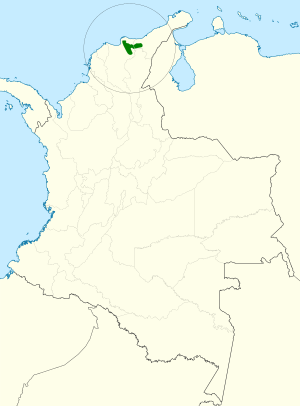Black-backed thornbill facts for kids
Quick facts for kids Black-backed thornbill |
|
|---|---|
 |
|
| Conservation status | |
| Scientific classification | |
 |
The black-backed thornbill (Ramphomicron dorsale) is a tiny, beautiful hummingbird that lives in the mountains of northern Colombia. It's known for its unique black back and very short bill. This special bird is currently an Endangered species. This means it is at risk of disappearing from our world.
Contents
Meet the Black-backed Thornbill
This amazing bird is a type of hummingbird. It belongs to a group often called "coquettes." The black-backed thornbill is the only species in its specific group, making it quite unique! It shares its genus with another bird called the purple-backed thornbill.
What Does the Black-backed Thornbill Look Like?
The black-backed thornbill is a small bird. It is about 9 to 10 centimeters (about 3.5 to 4 inches) long. It weighs around 3.5 grams (about 0.12 ounces). Both male and female birds have a very short, black bill. The male's bill curves slightly downwards.
The male bird has velvety black feathers on its back. It has purplish feathers under its tail and a white spot behind each eye. Its throat is olive green. The rest of its belly is a mix of dark gray and reddish-brown with green dots. The male's tail is fairly long and deeply forked. It is purplish black.
Female black-backed thornbills have shiny grass-green feathers on their upper parts. Like the males, they also have purplish feathers under their tail and a white spot behind each eye. Their underparts are a creamy white color with green dots. The female's tail is shorter than the male's. The outer tail feathers have white tips.
Where Does the Black-backed Thornbill Live?
The black-backed thornbill lives only in one special place. This place is the isolated Sierra Nevada de Santa Marta mountain range. It is located in far northern Colombia.
This bird likes to live at the edges of humid forests. It also lives in "elfin forests," which are misty, high-altitude forests with small, twisted trees. Sometimes, it can be found in páramo areas. These are unique grasslands found above the tree line in the Andes mountains. The black-backed thornbill can be found from about 2,000 meters (6,560 feet) high. It can live as high as the snowline, which is around 4,600 meters (15,090 feet).
How Does the Black-backed Thornbill Behave?
Seasonal Movements
The black-backed thornbill moves to lower parts of the mountains during May and June. This might be to find food or better weather.
What Does It Eat?
This hummingbird eats nectar from flowers. It can find nectar at any height, from close to the ground to high in the treetops. It has been seen drinking nectar from many types of flowers. These include flowers from the Erythrina, Puya, and Salvia plant families.
The black-backed thornbill collects nectar in two ways. It can hover in the air in front of a flower. Or, it can cling directly to the flower. Besides nectar, it also eats insects. It catches insects while flying or picks them off flowers.
Breeding Habits
Scientists do not know much about how or when the black-backed thornbill breeds. More research is needed to understand its family life.
What Sounds Does It Make?
The black-backed thornbill makes several different calls. These include a short, dry rattling sound like "trrr." It also makes a long, descending rattle that sounds like "tsee-tttrrrrrrrr-tsee." Sometimes, it just makes single "tsee" notes.
Why Is It Endangered?
The IUCN (International Union for Conservation of Nature) has listed the black-backed thornbill as Endangered. This means it is facing a very high risk of extinction in the wild.
The bird lives in a very small area. The exact number of black-backed thornbills is not known. However, scientists believe its population is getting smaller. Its home is under serious threat from human activities. People are changing its habitat into farmland or using it for grazing animals. A small part of its range is protected inside a national park. This park helps to keep some of its natural home safe.
See also
 In Spanish: Colibrí piquicorto dorsinegro para niños
In Spanish: Colibrí piquicorto dorsinegro para niños


